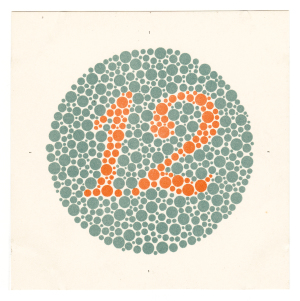 I am colorblind. This usually shocks people, for some reason. Amazingly, even after so many years of social and medical advancements, colorblindness is still rather unheard of and shocking to hear for most people. I grew up with it. One of my least favorite things is that when I tell people I’m colorblind, they immediately point to the nearest object and tell me to identify the color.
I am colorblind. This usually shocks people, for some reason. Amazingly, even after so many years of social and medical advancements, colorblindness is still rather unheard of and shocking to hear for most people. I grew up with it. One of my least favorite things is that when I tell people I’m colorblind, they immediately point to the nearest object and tell me to identify the color.
Colorblindness, genetically, is rather common but goes undiagnosed or, even when it is, can’t be treated. Colorblindness is caused by a genetic defect preventing the cones in one’s eyes to develop, not develop properly, or not exist entirely.
Deuteranopia, the most common form of colorblindness, is the reduced sensitivity to green light. Protanopia is the next most common, it being the reduced sensitivity to red light. There is a third, very rare form of colorblindness known as Tritanopia, and this is reduced sensitivity to blue light. According to tests I’ve taken, I’m a protanope, but I tend to mess up a lot of stuff.
Schools don’t really recognize or raise any sort of awareness about the genetic condition, which can be serious as well as obnoxious. Imagine being in a class, and they have you make a study guide in class by color coding it. Not so fun for the kid who is preconditioned to not understand which color is which. Or maybe this child is in art class…that shouldn’t need much more explanation. Also, try wiring anything electronic ever – it’s all color-coded!
If you were to consider a family with the smallest possible genetic possibility for having a colorblind child, NOT a carrier, the possibility is a solid 25%, because men have a 50/50 shot, whereas women have a much smaller chance.
The gene for colorblindness is carried on the X chromosome. So a girl could receive an X chromosome with a colorblindness gene, but then receive one without one, so it would be carried but inactive. It’s a recessive gene, so the functioning gene is dominant and will override it if present.
This means that one out of every four men you meet is most likely colorblind, representing a quarter of the male population. How is it that this condition isn’t better represented in society?
Colorblindness still comes as a surprise to people. There is little to no knowledge about colorblindness in the general public, and if it is as common as has been determined, that’s not a good thing. Growing up, I learned only a few things in regards to my colorblindness: art is going to be tough, forget being a commercial pilot, and good luck trying to wire your house.
Some people aren’t even aware they are carriers until they find out that their son is misidentifying colors and they take him to see an optometrist. It should be mentioned here that men cannot be carriers as they only have one X chromosome, so if they receive the chromosome with the colorblindness gene, they’re colorblind. The Y chromosome doesn’t affect colorblindness, besides making it easier to get it and impossible to just be a carrier.
Nowadays, colorblindness is talked about more, but it’s still a big unknown for most people. The biggest advantage, in my experience, is that colorblind people tend to not be fooled by camoflauge.
This is because their brains have been trained to think differently about color. People with trichromacy (normal color vision) can usually immediately identify a color without really thinking.
This process causes their brains to casually fill in spaces with similar colors and identify them as normal, allowing camoflauge to do its job. Colorblind people, on the other hand, have had to learn how to analyze colors in order to just casually identify them in everyday life, so this process of thinking is very useful when they have to look for the smallest details that may be out of the ordinary.
Overall, colorblindness can be a bit of a nuisance. People can still function in day to day life while being colorblind. I sure do! It can just make what seems like a normal, everyday activity extremely difficult. Just don’t ask me to tell you colors when I see you, pretty please.
-Cameron MacDonald
